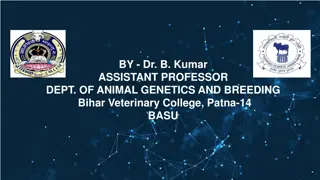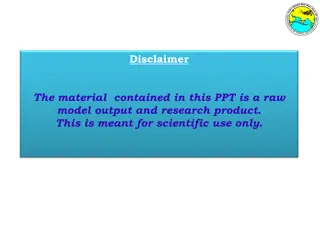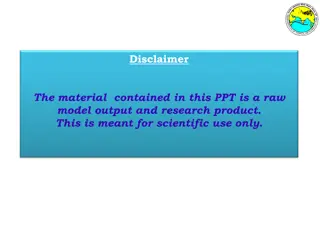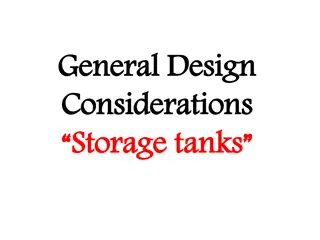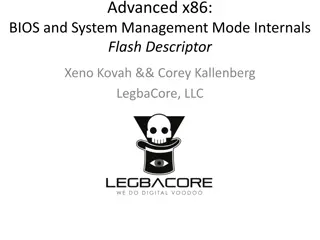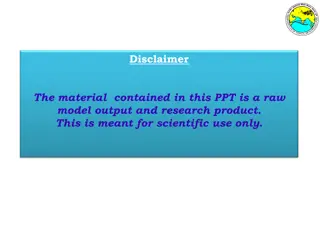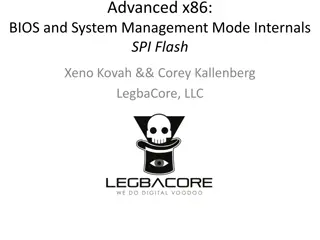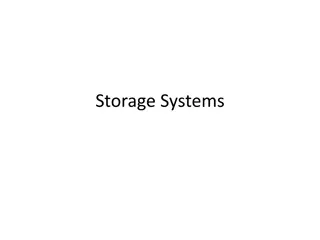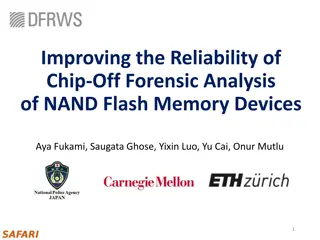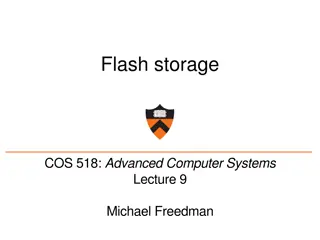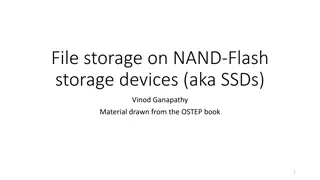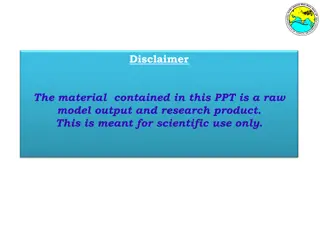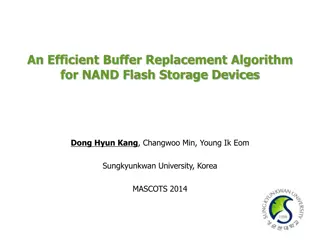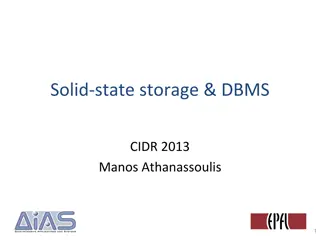Innovations in Flash Storage Technology and CORFU Applications
Explore the cutting-edge advancements in flash storage technology, particularly focusing on CORFU clusters and their potential to revolutionize data center systems. Learn about the design, applications, benefits, and implications of using CORFU in distributed SSD environments. Discover how CORFU addresses the trade-off between consistency and performance while enhancing fault tolerance and scalability.
Download Presentation

Please find below an Image/Link to download the presentation.
The content on the website is provided AS IS for your information and personal use only. It may not be sold, licensed, or shared on other websites without obtaining consent from the author.If you encounter any issues during the download, it is possible that the publisher has removed the file from their server.
You are allowed to download the files provided on this website for personal or commercial use, subject to the condition that they are used lawfully. All files are the property of their respective owners.
The content on the website is provided AS IS for your information and personal use only. It may not be sold, licensed, or shared on other websites without obtaining consent from the author.
E N D
Presentation Transcript
C O R F U Clusters Of Raw Flash Units Mahesh Balakrishnan, John Davis, Dahlia Malkhi, Vijayan Prabhakaran, Ted Wobber Microsoft Research Silicon Valley Thanks: Phil Bernstein, Ken Eguro, Jeremy Elson , Ed Nightingale, Colin Reid, Michael Wei, Ming Wu
tape is dead disk is tape flash is disk RAM locality is king - Jim Gray, Dec 2006
flash in the data center can flash clusters eliminate the trade-off between consistency and performance? what new abstractions are required to manage and access flash clusters? 3
what is CORFU? application infrastructure applications: key-value stores databases SMR (st mach rep) filesystems virtual disks application TOFU (trans over) append(value) read(offset) CORFU Replicated, fault-tolerant append read from anywhere append to tail network-attached flash 1 Gbps, 15W, 75 s reads, cluster of 32 server-attached SSDs, 1.5 TB 0.5M reads/s, 0.2M appends/s (4KB) flash cluster 200 s writes (4KB) 4
the case for CORFU applications append/read data why a shared log interface? 1. easy to build strongly consistent (transactional) in-memory applications 2. effective way to pool flash: 1. SSD uses logging to avoid write-in-place 2. random reads are fast 3. GC is feasible 5
CORFU is a distributed SSD with a shared log interface getting 10 Gbps random-IO from 1TB flash farm: Configuration Unit cost Unit power consumption Summary ten SATA SSDs in 1Gbps server $200/SSD + $2K/server 150W $22K 1500W fault tolerance incremental scalability competition individual PCI-e controller in 10 Gbps server $20K/Fusion-IO controller + $10K/server 500W $30K 500W fault tolerance incremental scalability ten 1Gbps CORFU units (no servers) $50/raw flash + $200/custom- made controller 10W $2.5K 100W fault tolerance incremental scalability CORFU
the CORFU design CORFU API: read(O) append(V) trim(O) mapping resides at the client application CORFU append throughput: # of 64-bit tokens issued per second CORFU library read from anywhere append to tail sequencer filled 1 filled 2 filled 3 filled 4 filled 5 filled 6 filled 7 filled 8 filled 9 10 11 12 13 14 15 16 4KB log entry each logical entry is mapped to a replica set of physical flash pages 7
CORFU throughput (server+SSD) [CORFU: A Shared Log Design for Flash Clusters, NSDI 2012] capped at sequencer bottleneck scales linearly 8
the CORFU protocol: mapping client D1/ D2 L0 L4 ... D5/ D6 L2 L6 ... D7/ D8 L3 L7 ... D3/ D4 L1 L5 ... page 0 page 1 application read(pos) D1 D3 D5 D7 CORFU library D2 D4 D6 D8 read(D1/D2, page#) Projection: D1 D2 D3 D4 D5 D6 D7 D8 CORFU cluster L0L1L2L3L4L5L6L7 . . 9
the CORFU protocol: tail-finding client CORFU append throughput: # of 64-bit tokens issued per second reserve next position in log (e.g., 100) sequencer (T0) application read(pos) append(val) D1 D3 D5 D7 CORFU library D2 D4 D6 D8 write(D1/D2, val) Projection: D1 D2 D3 D4 D5 D6 D7 D8 CORFU cluster 10
the CORFU protocol: (chain) replication client C1 client C2 client C3 safety under contention: if multiple clients try to write to same log position concurrently, only one wins durability: data is only visible to reads if entire chain has seen it
handling failures: clients client obtains token from sequencer and crashes: holes in the log 0 1 3 4 5 7 8 9 solution: other clients can fill the hole fast fill operation in CORFU API (<1ms): -completes half-written entries -writes junk on unwritten entries (metadata operation, conserves flash cycles, bandwidth)
handling failures: flash units each Projection is a list of views 0 - 0 - 7 0 - 7 8 - 8 9 Projection 0 Projection 1 Projection 2 D1 D2 D3 D4 D5 D6 D7 D8 D5 D6 D7 D8 D7 D8 9 - D1 a D3 D4 D3 D4 D5 D6 D1 D9 D3 D4 D5 D6 D7 D8 D7 D8 D1 a D1 D9 D3 D4 D5 D6 D10 D11 D12 D13 D14 D15 D16 D17 0 0 0 1 1 1 2 2 2 3 3 3 4 4 4 5 5 5 6 6 6 7 7 7 8 9 D10 D12 D14 D16 D1 D3 D5 D7 D9 D2 D4 D6 D8 D11 D13 D15 D17
handling failures: sequencer the sequencer is an optimization - clients can instead probe for tail of the log log tail is soft state - value can be reconstructed from flash units - sequencer identity is stored in Projection
from State-Machine-Replication to CORFU [From Paxos to CORFU: A Flash-Speed Shared Log, ACM SIGOPS, 2012] SMR form a sequence of agreement decisions leader-based solutions: leader proposes each entry to group of replicas same leader, same replicas, for all entries throughput capped at leader IO capacity scale-out through partitioning: multiple autonomous sequences CORFU decide on sequence of log- entry values CORFU-chain: first in chain proposes value (due to seq cer, no contention) each entry has a designated replica-set throughput capped at rate of sequencing 64-bit tokens scale-out by partitioning over time rather than over data Corfu Paxos
how far is CORFU from Paxos? Paxos instance Paxos instance Paxos instance A0 C0 A0 B0 B0 C1 A1 B1 C0 C2 A2 B2 A1 C3 A3 B3 B1 C1 CORFU partitions across time, not space (CORFU replica chain == Paxos instance) ...
TOFU: lock-free transactions with CORFU application where is your data? TOFU library read/update (key, version, value) did you and I do all reads/updates atomically? key vrs val versioned table store (BigTable, HBase, PacificA, FDS) k 3 5 18
TOFU: lock-free transactions with CORFU application key locator k o lookup TOFU library read/update (key, version, value) entries update index versioned table store (BigTable, HBase, PacificA, FDS) 19
TOFU: lock-free transactions with CORFU application key locator k o lookup TOFU library CORFU library read/update (key, version, value) entries append commit intention- record construct index by playing log versioned table store (BigTable, HBase, PacificA, FDS) 20
TOFU: lock-free transactions with CORFU application key locator k o lookup TOFU library CORFU library read/update (key, version, value) entries append commit intention- record construct index by playing log ref intent conflict zone versioned table store (BigTable, HBase, PacificA, FDS) 21
CORFU applications key-value store what: data + commit why: multi-put/get, snapshots, mirroring database (Hyder, Bernstein et al.) what: speculative commit records why: decide commit/abort C O R F U virtual disk storage what: volume sectors why: multiplex flash cycles / IOPS / bytes state machine replication what: proposed commands why: order/persist commands others: metadata services, distributed STM, filesystems 22
grieving for HD Denial: too expensive, vulnerable, wait for PCM Anger: SSD-FTL, use flash as a block-device random writes exhibit bursts in performance duplicate functionality Bargaining: use flash as memory-cache/memory-extension Depression: throw money and power at it, PCI-e controllers Acceptance: new design for farms of flash in a cluster
CORFU Beehive-based flash unit [A Design for Network Flash, NVMW 2012] Beehive architecture over BEE3 and XUPv5 FPGAs Multiple slow (soft) cores Token ring interconnect Vehicle for practical architecture research
Conclusion CORFU is a distributed SSD: 1 million write IOPS, linearly scalable read IOPS CORFU is a shared log: strong consistency at wire speed CORFU uses network-attached flash to construct inexpensive, power-efficient clusters
reconfiguration to reconfigure, a client must: 1. seal the current Projection on drives 2. determine last log position modified in current Projection 3. propose a new Projection to the auxiliary as the next Projection an auxiliary stores a sequence of Projections - propose kth Projection; fails if it already exists - read kth Projection; fails if none exists why an auxiliary? - can tolerate f failures with f+1 replicas - can be implemented via conventional Paxos reconfiguration latency = tens of milliseconds 27
flash unit design device exposes sparse linear address space three message types: read, write, seal write-once semantics: reads must fail on unwritten pages writes must fail on already written pages bad-block remapping Three form factors: FPGA+SSD: implemented, single unit server+SSD: implemented, 32-unit deployment FPGA+flash: under development 28
the FPGA+SSD flash unit BeeHive architecture over BEE3 and XUPv5 FPGAs BEE3: 80 GB SSD, 8 GB RAM power: 15W tput: 800 Mbps end-to-end latency: reads: 400 secs mirrored appends: 800 secs
garbage collection once appended, data does not move in the log application is required to trim invalid positions invalid entries valid entries log address space can become sparse 30
the CORFU cluster (server+SSD) $3K of flash 32 drives, 16 servers, 2 racks Intel X25V (40 GB) 20,000 4KB read IOPS each server limited by 1 Gbps NIC at 30,000 4KB IOPS mirrored across racks max read tput: 500K 4KB IOPS (= 16 Gbps = 2 GB/s) max write tput: 250K 4KB IOPS 31
flash unit design NAND Flash (8 Channels) SATA Channel 0 SATA Channel 1 Metadata Core Write Core Read Core NAND Core SATA Core Message Processing Core Gigabit Ethernet Core BeeHive Core DDR2 Controller System Control Core Gigabit PHY TC5 Controller DDR2 Memory (8GB) RS232 Serial FPGA Fabric (Temp, Volt) GPIO - message-passing ring of cores - logical separation of functionality + specialized cores - slow cores (100 MHz) = low power (15W)
flash primer page granularity (e.g., 4KB) fast random reads overwriting 4KB page requires surrounding 512KB block to be erased erasures are slow erasures cause wear-out (high BER) SSDs: LBA-over-log no erasures in critical path even wear-out across drive 33



